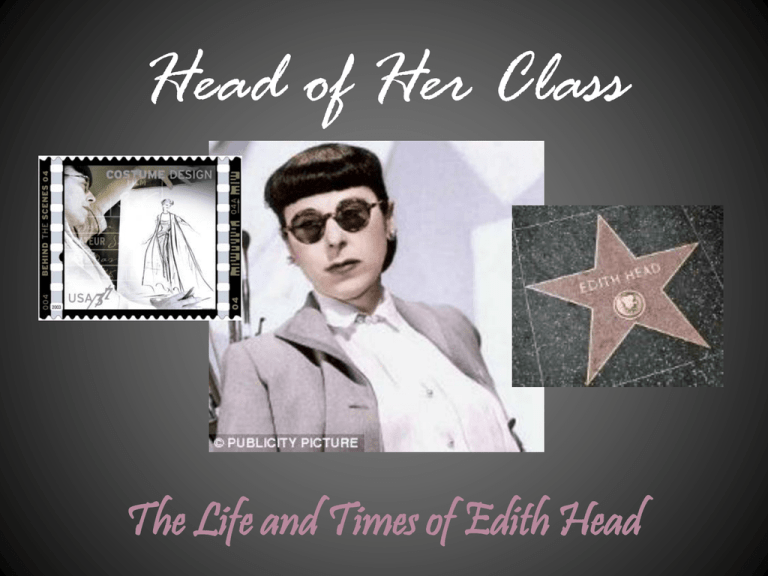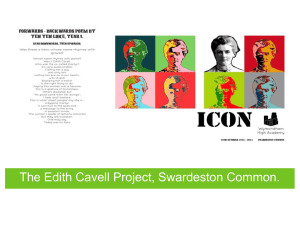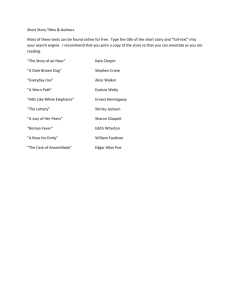Ahead of Her Class
advertisement

Head of Her Class The Life and Times of Edith Head Edith Claire Posener ● Born on October 28, 1897 in San Bernardino, California to Max Posener, a Prussian immigrant and Anna E. Levy, a former resident of Missouri. ● There are no records of whether or not her parents were married, but shortly after opening a haberdashery shop in San Bernardino her father’s business failed and by 1905 her mother married Frank Spare, a mining engineer who raised Edith as his daughter. They lived in Searchlight, Nevada but moved frequently for Frank’s work. ● In 1919, Edith received a Bachelor of Arts degree from the University of California, Berkley in French. She got her Master’s degree in Romance Languages a year later from Stanford University. ● Her first job was teaching French at Bishop’s School in La Jolla, California. After a year Edith took a position teaching French at the Hollywood School for Girls. Wanting a raise in pay, she told the school’s directors that she could also teach art, even though she had only taken a few courses in high school. To improve her art skills, she concurrently took art lessons in the evening at Chouinard Art College and succeeded in her classes and new position at work. ● While at Chouinard, her friend Betty Head introduced Edith to her brother Charles. They married on July 25, 1923 but divorced in 1936 after a long separation. Despite the split, she kept his last name which she had used professionally for many years. In 1940, she married set designer Wiard Ihnen The Golden Age of Hollywood The Studio System ● The Golden Age of Hollywood encompassed the years 1930-1948 and came with two important advancements—sound and the vertically integrated studio system. ● Vertical integration came when the studios realized that they could maximize their profits by controlling all aspects of a movie’s life: production, distribution and exhibition. ● The ‘Big Five’—Warner Bros., Paramount, 20th Century Fox, Lowes (MGM) and RKO (Radio-Keith-Orpheum) achieved complete vertical integration by the 1940s while the ‘Little Three’—Universal, Columbia and United Artists also made pictures, but lacked some of the elements of vertical integration. Together these eight companies controlled 95% of the movie industry. ● The big studios wanted to make money first and art second. They accomplished this by controlling how movies were distributed to theaters and what highly desirable movies theatre owners wanted to buy and what less desirable movies they had to buy. ● The studios also hedged actors and tradespeople into long contracts that required them to work long hours on any project that the studio heads sent them to. These projects were usually in-house, but the studios also rented out their talent. They also tightly controlled their employees’ image and personal lives. ● The result of this system was that each studio had its own roster of stars/tradespeople and its own signature style of filmmaking. The industry was very stable, but working conditions were not ideal. ● It was into this system that the young Edith found herself employed when in 1924 she was hired by Paramount Pictures as a costume sketch artist, although she had no real artistic background or previous experience designing costumes. Something Borrowed ● Edith had been hired to Paramount by notable designer Howard Greer. She longed to do something more exciting and profitable than teaching and “I figured I could fake it but…” she didn’t know how to figure sketch. She fessed up to Greer that the portfolio that she had showed him were actually the work of her friends at Chouinard’s. “Instead of firing me, Howard started teaching me how to sketch. He thought the whole thing very funny.” ● Her first film was Cecil B. DeMille’s The Golden Bed, in which she designed costumes for the Candy Ball and learned not to design things one couldn’t make. She also designed animal costumes and costumes for extras and smaller roles, working her way up to junior designer. ● As a junior designer, she was allowed to design for B-Westerns and it was during this time that she gained much of her knowledge of design and actual stitching. Although she was criticized for her early work, she persisted when she discovered “…what to me is magic—that you can actually change a person with clothes.” On Her Own ● She Done Him Wrong (1933) was Edith’s first picture with a major star, Mae West. The movie launched her career. ● When mentor Travis Banton resigned from Paramount in 1938, it was her time to shine! ● Her design for Dorothy Lamour’s ‘sarong’ dress in The Hurricane (1937) made her a household name. The Paramount Years ● Edith worked for Paramount Pictures for 43 years. By the 1940s her career was in full bloom. ● At Paramount she worked with a bevy of famous actresses such as Ginger Rodgers, Bette Davis, Barbara Stanwyk, Shirley MacClaine, Grace Kelly, Audrey Hepburn, Elizabeth Taylor, Mae West, and Natalie Wood amongst others! ● In an age of impersonal business relationships under the studio system, Edith was known for befriending the actors she worked with. She was known for her low-key working style and for consulting with the stars she clothed. As a result she became a favorite of many female stars and was often ‘lent out’ to other studios. The Legend Begins… ● In 1949, the Academy of Motion Picture Arts and Sciences added the category of Costume Design to its annual awards and Edith began her sweep of the category with a total of 35 nominations and eight wins. In her lifetime, she worked on 1,131 films. ● She was awarded an Oscar for The Heiress (1950, Black & White), Sampson and Delilah (1951, Color), All About Eve (1951, Black & White), A Place in the Sun (1952, Black & White), Roman Holiday (1954, Black & White), Sabrina (1955, Black & White), The Facts of Life (1961, Black & White), and The Sting (1974). The Designs Criticism ● In the 1950s, she was dubbed by her critics as the ‘Queen of the Shirtwaisters.’ However the conservative appeal of this costuming trend was favored by frequent collaborator Alfred Hitchcock and Hal Wallis, as well as studio executives who wished for their pictures to have a more timeless appeal. ● Edith was sometimes criticized for her informal working style and conservative styling. This brought in into conflict with some stars, most notably Claudette Colbert. ● Later in life, she was sometimes criticized for passing off others’ designs as her own. While this may have been true, it was common under the studio system for a department head to claim the work of their employees as their own. ● She was also said to have been against the unionization of the film industry. The Universal Years ● In 1967, Edith left Paramount to work for Universal. She worked there until her death in 1981. ● As the studio system declined, Edith began working on television shows as well as film. She won her last Oscar in 1974 for her work in the movie The Sting. ● She was also known for her work on the beloved T.V. miniseries Little House on the Prairie. Honors & Achievements ● Edith worked on over 1,000 productions in her lifetime, 35 of which were nominated for Academy Awards and eight of which actually won her an Oscar. She has won more Oscars and has been honored more than any other woman in history. ● She has a star on the Hollywood Walk of Fame and had her hand prints immortalized at Graumann’s Chinese Theatre. She was the first woman to win fame as a costume designer. ● In 2003, a 37₵ U.S. postage stamp was issued with her image on it to commemorate the field of costume design. Legacy Books & Publications ● Edith authored three books, The Dress Doctor with Joan Kesner Ardmrore (1959), How to Dress For Success (1967) and Edith Head’s Hollywood with Paddy Calistro (published posthumously in 1983). These books demonstrate the sharp wit and one-line zingers she was known for. They are also a rather humorous look into the past. ● She was also known for her fashion articles and for influencing the dress of everyday American women in a time when movies dictated fashion styles rather than reflecting them. ● Unlike other designers of her time, Edith connected with the average American woman. Her fashion advice was considered indispensable for both stars and their fans. To capitalize on her importance, she was invited to design ready-to-wear patterns for Vogue and Advance. End of an Era ● The studio system that developed during the Golden Age of Hollywood was gone by the late 1970s and early 1980s, but Edith did not stop working on film. Her last movie was called Dead Men Don’t Wear Plaid (1982) and starred Steve Martin and Carl Reiner. It was dedicated to her memory. ● One of her final achievements was designing a new uniform for the women of the Coast Guard, for which she was awarded the Meritorious Service Award. ● Throughout this period, Edith kept working until her death on October 24, 1981 from a bone marrow disease. Homage ● In 2001, actress and playwright Susan Claassen debuted her one-woman show “A Conversation with Edith Head,” in which she plays Edith in 1981. The show has been seen around the world. ● Disney/Pixar’s 2004 film The Incredibles features a costume designer for super heroes known as Edna Mode who bears a striking resemblance to Edith in looks and mannerisms. Sources ● “Edith Head,” imdb.com ● American Film Institute “Classical Hollywood Cinema” http://www.fathom.com/course/10701053/s ession2.html ● “Edith Head” http://www.papierdoll.net/themag/2006/03 /01/ppdoll-355/ ● Lesley M. M. Blume. “Icon of Style: Edith Head, The Most Famous Costume Designer of All Time” http://www.huffingtonpost.com/lesley-m-mblume/edith-head-costumes-photos-letsbring-back_b_776365.html#168828






